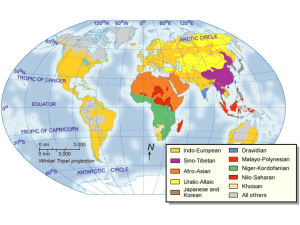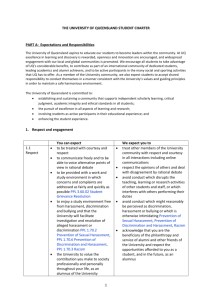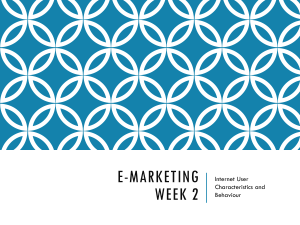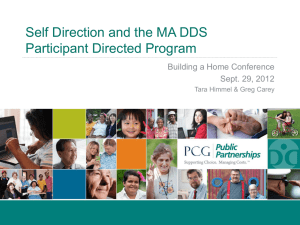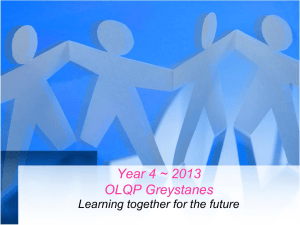En ny gymnasieskola
advertisement
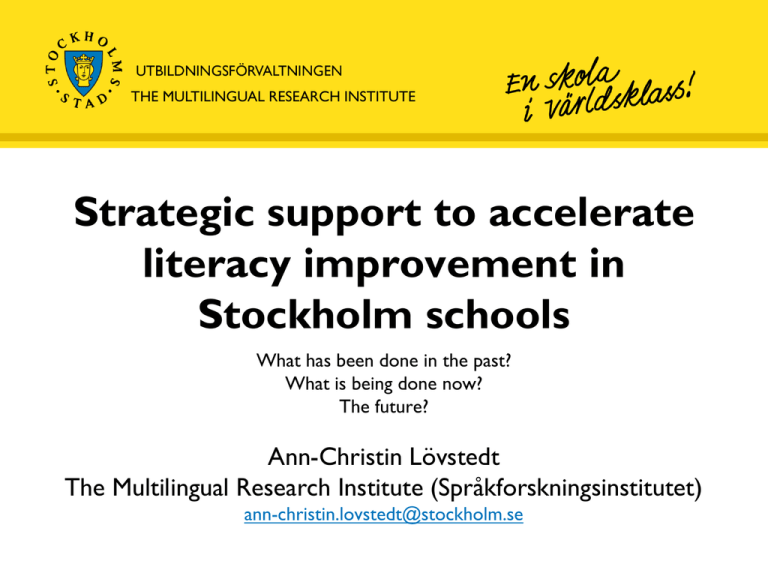
THE MULTILINGUAL RESEARCH INSTITUTE Strategic support to accelerate literacy improvement in Stockholm schools What has been done in the past? What is being done now? The future? Ann-Christin Lövstedt The Multilingual Research Institute (Språkforskningsinstitutet) ann-christin.lovstedt@stockholm.se The current situation is that… …compared to their native Swedish peers, immigrant students, on average, have weaker educational outcomes at all levels of schooling. Nearing the end of compulsory education, at age 15, there are very significant performance disadvantages for immigrant students. …egalitarian policies notwithstanding, immigrants fare poorly, compared to Swedish natives. Their educational experience is not much better than that of immigrants in other countries. OECD Reviews of Migrant Education, 2010 …there has been an increase in the gap between children from highly educated, high income families and children from unskilled, low income and families. SCB, 2010 A lot of money has been spent to improve migrant students’ results 1999-2004/2005: Metropolitan Policy (Storstadssatsningen). The government budgeted 2 billion SEK to improve living conditions in diverse, urban areas. Part of it was spent on education improvements. 2004-2006 the City of Stockholm budgeted 35 million SEK for measures to accelerate literacy learning and and close the achievemnet gap, especially among second language learners and disadvantaged students. The project ”Language and content development in the City of Stockholm” (”Språk- och kunskapsutveckling i Stockholms stad”) was given almost 19 million SEK. Professional development Action research projects Courses Mother tongue Lectures… Pre-/primary/secondary schools A lot of things were done… Reading literacy Mother tongue support 7 initiatives 14 initiatives Individualization of instruction at upper secondary school and adult education 8 (action) research projects Action research project about children’s language development in preschools Action reserach project about the integration of language in the content areas of science and humanities in secondary school Action research project about literacy But in spite of all that, the gap is still there Gap: 28 percentage points Stockholm students meeting the requirements to enter Year 10 (2009) SIRIS, Skolverket, 2010 The Multilingual Research Institute 2010 1998 - Second Language Acquisition in general - L1 support/development - Intercultural approaches - (Action) research - All areas of society 2005 - The language of schooling - Second language teaching strategies - Teachers of Swedish as a second language + other teachers - The education area - The language of schooling - Teahing strategies for ALL teachers - The language in the content areas - Genre pedagogy - Building capacity of whole school - Literacy learning for disadvantaged groups - Strategic support to preschools and schools ”Language & content” PD offers based on SFL theory Level 3: Reading to Learn Level 2: - Mathematics and genre pedagogy (R2L methodology) - Science, language and genres Level 1: - Scaffolding for Success with Genre-based Pedagogy - Introduction to genre-based pedagogy and the notion of scaffolding Level 1 Scaffolding literacy learning (scaffolding strategies) in all subjects Introduction to the Genre Approach to writing and supportive reading strategies across the curriculum Using the functional model of language as a tool to analyse and plan effective literacy instruction Building capacity and creating independent school literacy development through proffessional action learning teams Teaching-learning cycle (from Rothery 1994) Level 2 Understanding the specific language of different subjects Teaching strategies (connected to the functional model of language) Building knowledge about language (KAL) that enhances student learning in all subject areas Level 3 An intensive approach to literacy and learning that targets both reading and writing and can be used in primary, secondary and tertiary education Re-writes the classroom discourse pattern to scaffold the understanding of age approapriate curriculum texts Uses what is learnt from reading as a powerful resource to enable the writing of high quality, age approaporate texts in all subjects Action research based (data collection) Initiate-ResponseFeedback cycle Reading to Learn scaffolding cycle Initiate Feedback Prepare Respond Elaborate Task Generations of genre based pedagogies (in Australia) 2000s reading across the curriculum Reading to Learn 1990s writing across the secondary curriculum Write it Right 1980s writing in the primary school Writing Project The Stockholm Reading to Learn Project 2009-2010 7 schools: low, medium, high socioeconomic status 22 teachers 9 generalist teachers 9 subject specialist teachers 4 special needs teachers Year levels of students taught K – Year 3: 5 Year 4 – 6: 6 Year 7 – 9: 9 Year 10 – 12: 2 Data from 58 students year 1: 6 students year 4: 18 ” year 6: 6 ” year 7: 6 ” year 8: 12 ” year 10: 6 ” Mainly second language learners High, average, low performing students Program design Time span: A whole school year (September 2009/May 2010) PD dates: 4 two-day workshops for the teachers: October, December, March and May PD content: Reading to Learn D. Rose (2009) www.readingtolearn.com.au Teacher requirements: study the R2L modules and CD between the workshops implement the R2L cycle at least 3 times (lessons) per week video record some of the R2L lessons collect data on student achievement (see below) Support from project staff: school visits between workshops: feedback on video recordings, discussion about implemention of R2L and assessment of students texts etc. Final conference: Dr David Rose and Ass. Prof. Kristina Love as keynote speakers; teachers presenting workshops on their implementation of R2L Data collection Selection of 6 focus students by every teacher: 2 high, 2 medium and 2 low performing students Standardised reading comprehension test (DLS) - pre and post program implementation from every focus student (and the whole class) Assessment of student texts by the teacher, (factual and narrative genres pre and post the implementation of R2L) using R2L assessment criteria (David Rose, 2009) Data about teachers, schools and students Ongoing evaluation data at the teacher workshops and during the school visits: documentation, teachers’ own view points and experiences about the implementation of R2L, their narratives about student performances etc. Findings Development of writing in R2L: narrative Assessment score Sample of 20 students from 3 schools Pre Post High Average Low Growth=33% Growth=37% Growth=128% Assessment score Development of achievement in reading comprehension test (sample of 26 students in 3 schools) Pre Post Medium Assessment score Top and bottom students cohorts averaged across classes year 4-8 (reading comprehension test) growth=45% L pre to post growth=12% H pe to post gap = 52% gap = 38% Assessment of growth in Year 10 Eva Oivio, Hässelby gymnasium - new arrivals program Reading test results based on Common European Framework of Reference for Languages My dear friend! I’m worried that I don’t have frends. I don’t foroget when we climbed trees and xxxx. We play together with me. I deremed often.When came I Swede i chenged temperament. Because I was alone all the time. but maybe know you not how much mis you. I want back before the life that lived we. When we contact each other I so glad but now totally saad. I stop to laugh i thinck you often. Now know I not where you the life your mobile didn’t answer maybe spok you I don’t want to stotop contat me and you. One day will I Somalia hope that we see each other in Somalia. you are sad after me. I know you are lonely. I don’t want leave alone. but is war therefore escap I to Swede Sweden is peace country I so very glad. I go school free and food . Hope I that will the war end. and we see each other when there Give my greetings to all friends don’t forgat me. I miss you much kiss and hug xxxx= unintelligable Year 10 Eva Oivio, Hässelby gymnasium new arrivals program Pre-program writing sample Something I will never forget It happened in may and the weather was suffocatingly hot and the sun stood in the middle of the sky. I visted my friends and neigbour before I was going. After that I dressd and I stoodd in fron of the mirror and saw myself. I was nervous and I was extremely distressal I left my mother and litle brother. My mother and I hugged each other in bosom a warm and I didn’t let go but I want be left in my mother’s bosom. We had taken a taxi out from city to airport. My mother was very understandin and she comfort me that I would retun a dey and we would meet in a ordinar way. She said that everything would be all right and that it was jus cal if it was something. we passed several the fields and there are no bigg house just huts.The car turned to the right. We saw a lot of people stod in front of airport some of they return home. I was in the aircraft and my mother stayed outside in the airport.The planes started to fly. I don’t believe to see my mother a dey on life. When my mother disappeart in the down in aircraft. I began to dispair my eyes the tears ran I became worried and felt sorrow in my my heart. I come another country that was differ from my home country.The country has a heterogeneous population and the language was different of my language. I come out in Arliland I saw my cousin who waited for me. We embraced each other.Then drove we awau from Arliland towards home. I felt loneliness and I thoughd a loit my mother and my little brother. I was in bad in mood The next day I callade my mother and I felt glad. Aftyer several month I talked her that I would visit her. Suddenly my mother didn’t want to visit her. I was surprisede. Mother said she was going to come here. I was very glad to again see my mother and my little brother. After a year ago my mother and brother got their residence permi in Swedan. I felt big joy. After a wek called and she said that would come tomorrow.The next day I went to airport and waited them in the airport. I lookedhappy. Suddenly, I saw my mother coming out of the big door look around her self, her eyes searching, catch sight of her longed-for daughter. We embraced each other. I felt glad andf safety and sucked in the lovely fragrance of mother. We looked nicely. In time ended worried and on the contrary I happy when my familj livred I again. Year 10 Eva Oivio, Hässelby gymnasium - new arrivals program Post program writing sample Teacher observations about Successes for Students Some examples….. Students are becoming more literate, that is they are not just decoding, they are developing deeper understanding Good progress students can be taught by anyone – students who struggle are the challenge for teachers and R2L provides a methodology for these students Students are now implementing the R2L strategies independently The achievement gap between the highest and lowest achievers decreases Students understand content of subjects better Students are now writing well structured texts and achieving well in National Tests Teachers’ comments about their own learning Some examples…. Teachers “dare” to use more difficult texts Before R2L teachers didn’t have a methodology to work with texts, students often copied and drew pictures Teachers can now use more difficult texts and a wider range of genres eg. not just simple stories in the primary school Previously teachers just hoped that a lot of reading in general would be enough Elaborations take all students understandings to a higher level Other teachers can see the difference between students who are doing R2L and students from other classes who are not We are now teaching to the weakest students not just the top ones Learnings of the project team … Teachers need time – besides the workshops – to deepen their knowledge about R2L and the language in their specific subject areas The importance of being explicit and clear about the data collection Reading comprehension tests not totally satisfactory (culturally biased) It is possible to accelerate the literacy development for all students The low performing students enhanced their learning and became more active learners Hard work pays off! Even very experienced teachers articulated that although it was hard work, it was the most worthwhile PD they had ever participated in and they had never seen such a dramatic improvement in student writing before ! R2L engages all students and gives them access to abstract and theoretical knowledge from reading. We no longer need to dumb down the curriculum! Reading to Learn 2010/2011 In Stockholm: 70 Stockholm teachers in the training program 22 teachers (from last year’s project) in a R2L Mentor program In Sigtuna: 17 secondary teachers from one specific school in another municipality in the training program Future needs of Stockholm schools Ongoing efforts to build capacity through school-based Professional Action Learning Teams Ongoing support for school-based Literacy Leaders Ongoing training of teachers in the R2L methodology Professional Development for school leaders to become effective leaders of literacy and learning Further specific literacy Professional Development for teachers of all subject areas
